Retro machines seem to be coming to the fore over the past few years, feeding into that hipster-vintage vibe where everyone looks at things through sepia Instagram filters. While Kawasaki waved bye-bye to the W800, BMW’s RnineT, along with Triumph’s Bonneville range of the T120 Speed Twin, the Thruxton R and the Street Twin, seem to be going from strength to strength.
While the Japanese firms don’t seem to be doing too well in the retro-bike stakes, the European companies seem to be taking to the trend like a duck to water. No, Harley-Davidson doesn’t count, it’s been producing essentially the same bike for the last one hundred years.
Alongside BMW Motorrad and Triumph, Ducati entered the fray a few years ago with its Scrambler series of retro-styled V-twins. Based upon its Scrambler series of bikes from the 60s, the range of Scramblers from Ducati evokes an era of air-cooled engines, simpler times and emulating Steve McQueen (yes, we know McQueen favoured English bikes).
Since then, the Scrambler, in its various versions, has been something of a sales success for Ducati. This is in every way helped by the fact that the Ducati Scrambler Icon is designed for, dare we say it, the non-motocyclist, and for the rider who prefers form above function.
That Ducati has been pushing the “lifestyle” aspects of Scrambler ownership is no surprise. Most manufacturers make more money from sales of after-market accessories and clothing, with the resultant higher margins and lower after sales service required.
Perhaps the most successful example of this would be Harley-Davidson, which has become perhaps the most recognisable name worldwide to non-bikers. Ducati has gone much the same way with the Scrambler, and its “Land of Joy” tagline to emphasise the lifestyle aspects of owning a motorcycle.
To say the campaign was a success back in 2015 would be understating things a little. Sales of the Scrambler Icon contributed over 20% of Ducati’s revenue, echoing the sales success that was the Monster series of bikes back in the late 90s and early 2000s.
But, for some strange reason, you don’t see that many Ducati Scramblers on Malaysian roads. Which is a shame somewhat, because once you get past that “hipster-lifestyle-retro” thing, there actually is a capable motorcycle under the image of irony.
The reason why is that way too many Malaysian riders are hung-up about power ratings, and looks. The Scrambler looks like something your grandfather might have ridden, and that is by design, but underneath all that, is a motorcycle that makes no bones about the fact that is, indeed, a motorcycle.
On the first approach, the first thing that strikes you about the Ducati Scrambler is how small it is. And low. That 780 mm seat height will let anyone get a foot planted on the ground. Easy riding for experienced riders, great for newbies, you might think.
As we found out, the Ducati Scrambler may not necessarily be the bike for the newcomer, which we will explain in a bit. Suffice it to say, accommodations wise, the Scrambler allows any rider to get on without feeling intimidated.
This is simply because Ducati distilled the essence of the Scrambler down to its very basics. There is not much in the way of the unnecessary on the Scrambler Icon, harking back to the days of the universal Japanese machine (UJM) of the 70s.
Back then, there was very little sophistication to be found in motorcycles of any size, and as a consequence, riders made do with what they were given. This is much the case with the Scrambler Icon, except there is also an extensive catalogue of parts and accessories to make your Scrambler in your own image, as it were.
As we swung a leg over the Scrambler Icon’s somewhat flat seat, and dropped down into the saddle for a change – the last time this happened was with the Harley-Davidson Iron 883 – and grabbed the rather high-set handlebars, we noted the riding position as coming straight out of a 60s motorcycle design handbook.
Having cut our teeth on a Suzuki GS550E way back when, the position was instantly familiar. Removing the rose-tinted glasses, though, made us realise that while this riding position would be good for cruising city streets, more spirited highway riding might prove to be a challenge, as we were to find out.
Starting the Ducati Scrambler Icon sees the 90-degree V-twin settle into the familiar Ducati rumble. Displacing 803 cc, this particular engine is the distillation of many years of V-twin design, going back to the 900 and 750 Desmodromic twins of the 70s.
Some riders might scoff at the 75 hp at 8,250 rpm and 68 Nm of torque at 5,750 rpm in this day and age of 100-plus hp 600 cc engines. This would be a terrible under estimation of the fun that is to be had in the lower regions of the rev range.
Riding a motorcycle is not about outright horsepower, nor top speed, nor quarter-mile times. Taking a relatively under-powered engine – compared to more modern machinery – and riding the tits off it, is the mark of a skilled rider, especially when the roads and corners are tight and twisty.
As we pulled the clutch and engaged first gear on the Scrambler Icon, and prepared to move off, we encountered something we had not seen in a while outside of the racetrack, and wondered if this bike is actually suited for newbies and fair-weather riders.
The Scrambler Icon throttle response was sharp, razor-sharp. It was so quick, with zero lag, that we almost pulled an unintentional wheelie while leaving the front porch of Ducati Malaysia.
Trust us when we say the throttle of the Scrambler Icon is not to be trifled with, especially when pulling away from a start. The last time we rode a bike with hair-trigger throttle response like this was a WSBK bike from Ducati Corse.
So, if you are riding the Ducati Scrambler Icon for the first time, don’t let the 803 cc twin lull you into complacency. Exercise caution till you get used to the throttle response.
This was borne out by the fact that when we received the Scrambler from Ducati, it had scuffs and scratches on the levers and pegs, indicating that it had been dropped several times during its hard life as a media test bike. This didn’t distract from the rest of the Scrambler, as bikes of this ilk tend to wear battle scars with pride.
Riding the Ducati Scrambler Icon was easy as, with its low seat height and wide, high-set handlebars. We found the bars a little too tall for our taste, putting the rider’s torso in the path of much of the wind-blast. Not to fret, though, as a selection of handlebars of different widths, heights and rakes is available from the Scrambler catalogue.
As we took the Scrambler on a set of B-roads down south to Melaka, the riding position and medium speed made it a very enjoyable ride, especially with the company of a Moto Guzzi V7. The pair of air-cooled twins made a perfect match riding along the coastal road.
Handling on the Scrambler was without issues at medium to high speeds, the wide bars making turning effort easy. Dropping into corners just need a little nudge of counter-steer, and the Scrambler took the line without hesitation.
Transitions and flip-flops did need a bit of effort. Steering effort was not as intuitive as other machines in Ducati’s range, although the precise handling was there, it just needed a bit of work doing so.
This was, in part, due to the 18-inch front hoop. While it is in keeping with the Scrambler’s retro style, it does mean sticky rubber can be a little hard to find, if you prefer your fun with the horizon tilted at some crazy angle. The rear 17-incher poses no problems with tyre choices.
Speaking of handling, the Scrambler is built to a budget, for a Ducati, and this shows in the suspension. The front forks, with 150 mm of travel, were not adjustable for anything, and harsh at low speeds. The rear Kayaba absorber, adjustable only for pre-load, was hard enough in the rebound to catapult the rider out of the seat when taking sharp bumps.
At highway speeds, and slightly beyond, things are fine – if the roads are smooth. Strafing the b-roads and the usual condition of Malaysian roads, with its myriad of potholes, bumps, patches and uneven surfaces meant care had to be paid. Certainly, the suspension was hard enough, on some roads, to rattle the fillings in our teeth.
So, pay attention to tyre pressures (the only real suspension adjustment you have), and if you’re a lighter weight rider, something from the aftermarket may have to be considered to provide some adjustability. Heavyweights should have no issues.
The other thing we noticed was engine heat. While understandable coming from the Scrambler, it is a naked air-cooled twin after all, the heat was enough to feel a slight roasting going on in the rider’s inner thighs.
If you’re riding the Scrambler, leave the shorts at home and wear jeans, at least. The heat won’t boil your eggs, but if you’re stuck in traffic, it might come close.
Where the Scrambler Icon comes into its own is cruising curves and corners on country roads, and city streets. Chasing sports bikes in the canyons is not to be done unless you really know what you’re doing, since there are no fancy electronics to help out the ham-fisted rider.
Basic as it gets, the Scrambler only comes with front-and-rear ABS, and not much else. This is perhaps in keeping keeping in the ethos of the retro-styling in bikes such as the Icon and the BMW Motorrad RnineT, but, there is something to consider.
Many of the riders attracted to the styling of a bike such as the Scrambler are not likely to be “hard-core” sports riders, or riders coming back to the sport after the long lay-off. While not taking anything away from such riders, riding skills such as throttle control and the ability to tell the limit of tyre adhesion may be lacking in such riders.
What this means is with the lack of riding aids, a rider needs to keep the rear tyre under control, especially on sketchy surfaces. This was proven during a ride up the mountain, on corners made wet by the morning mist.
Traction was almost instantly lost when the throttle was whacked open, with the rear wheel going sideways rapidly. Very entertaining for the author, but not something recommended for the newbie.
But the Scrambler is entertaining, despite some of rather basic accommodations on the bike. Without all the fancy doo-dads and electronics, the Scrambler Icon is pretty much a motorcycle reduced to its essence.
Riding around the city with the Scrambler was indeed a lot of fun, and the quick acceleration from the V-twin’s 68 Nm torque allowed for quick overtaking. The rather small tank was a bit of a let-down though, with only 13.5 litres capacity.
Fuel consumption was about 6.9 litres per 100 km, according to the instruments, which sounds about right. This was helped by long stretches on the highway.
The single clock on the bars was a little funny though. The large LCD face was legible, but the tachometer was a bar at the bottom that read from right to left. It performed ok, but most riders are accustomed to seeing the tacho read from left to right, from the usual clock-wise sweep with the needle at the top.
With a wet weight of 186 kg, the Scrambler Icon is easily handled in the parking lot by any rider, and the brakes – a 330 mm disc with a radial Brembo Monobloc four-piston caliper in front and a 245 mm single-piston caliper at the back – are a good match for the Scrambler’s performance.
We certainly didn’t notice the lack of a second disc in front for braking duties, but keeping in mind that this is more of a “cruiser” than a sports bike, the trade-off was accepted. Just don’t expect to out-brake the competition into corners.
Going for a retail price of RM63,999, including GST and registration, excluding insurance, the Ducati Scrambler Icon is pretty much a fun bike that is accessible to almost any rider. Other options in the retro-style for this capacity range are the 2016 Triumph Street Twin, which retails at RM59,900, and the 2016 Harley-Davidson Iron 883 at RM89,000.
What it is, is a fun bike for the rider, and perfectly honest about its intentions. Easy riding around the country roads? Done. Cruising the city? Done. Daily rider, with the addition of a pair of throw-over panniers? Done.
That the handling isn’t razor-sharp scary, and the more than adequate amount of roll-on torque, makes the Ducati Scrambler Icon ideal for a multitude of roles, especially for the rider who doesn’t want the typical hard-edged and blunt styling of the current crop of naked sports bikes.
Looking to sell your car? Sell it with Carro.

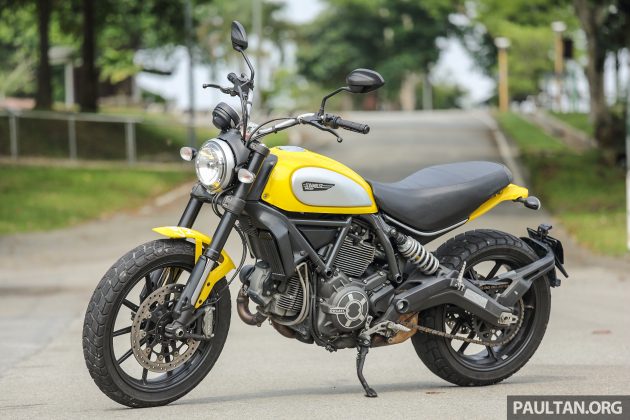
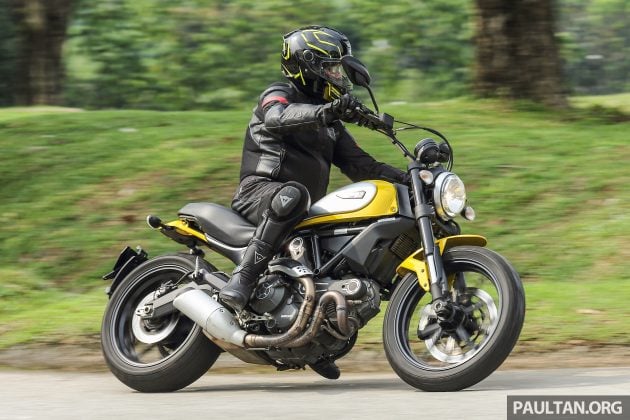
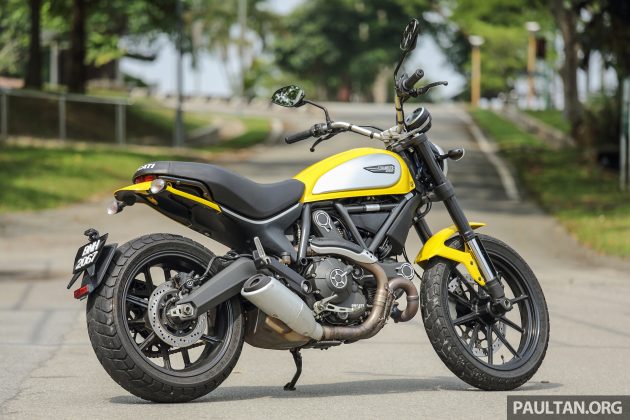



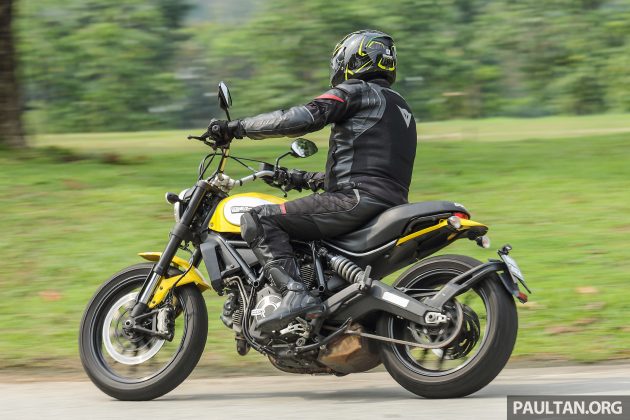



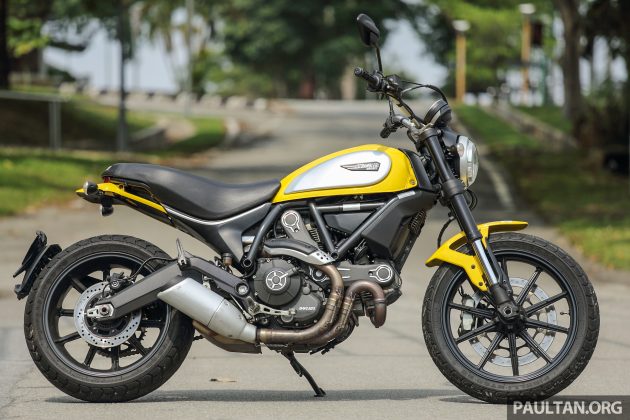





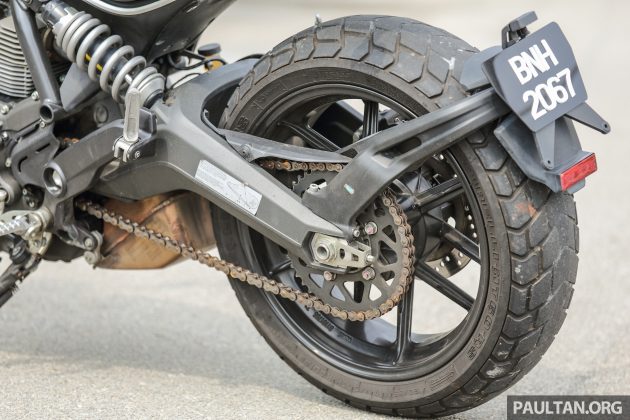



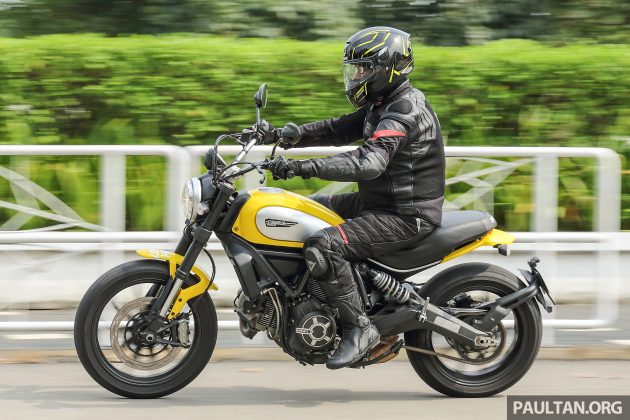
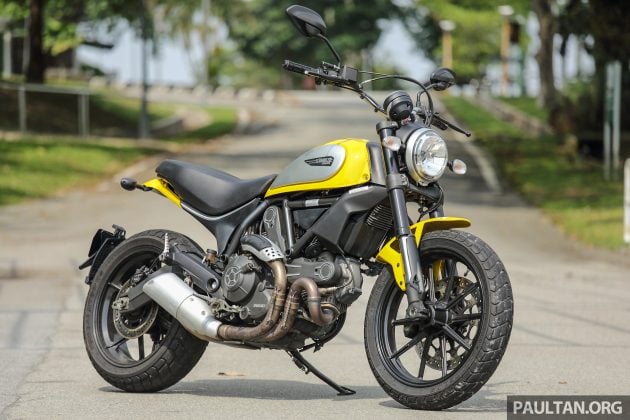




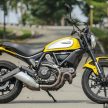
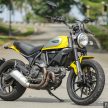
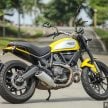
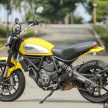
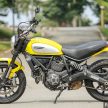
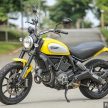
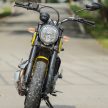

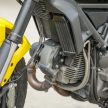
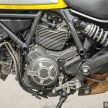
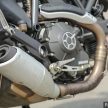
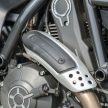
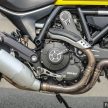
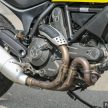
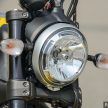
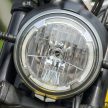
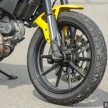
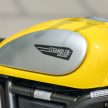
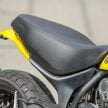
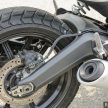
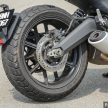
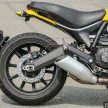
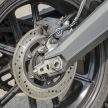
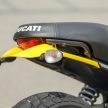
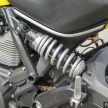
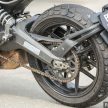
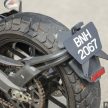
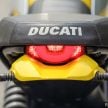
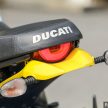
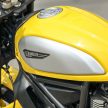
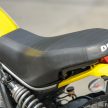
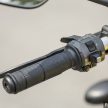
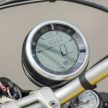
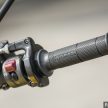
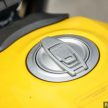
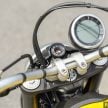
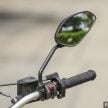
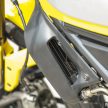
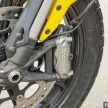
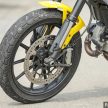

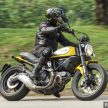
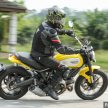
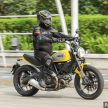
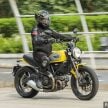

Nice review… no bias and the important points are well covered. Keep up the good work.
Even though I don’t ride, I really do enjoy reading your reviews. +1 for getting “tits” past the editor by the way!